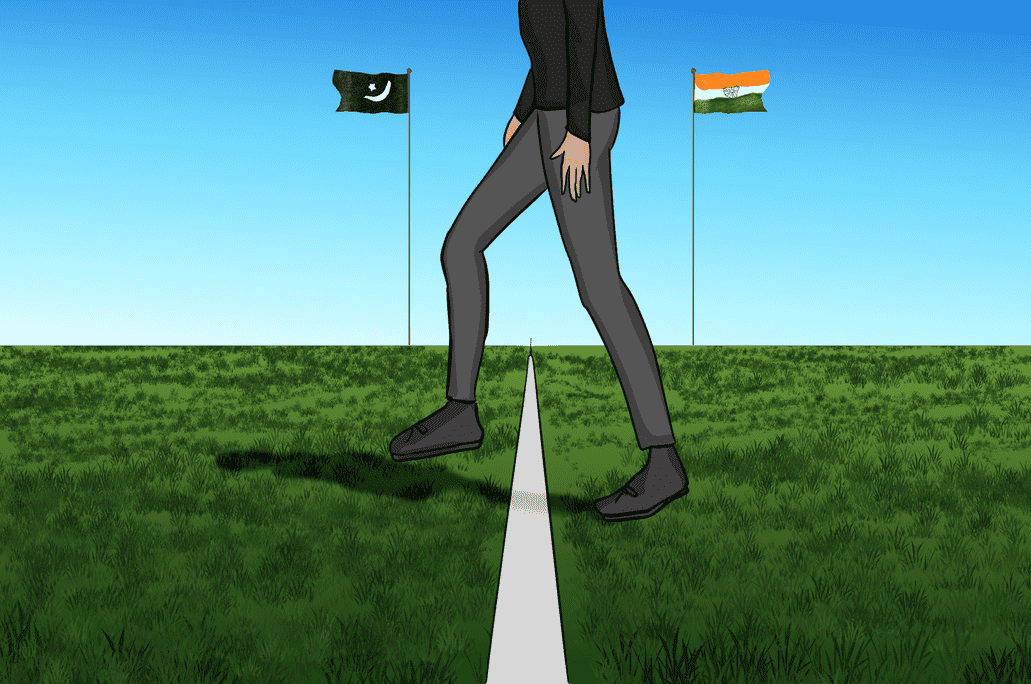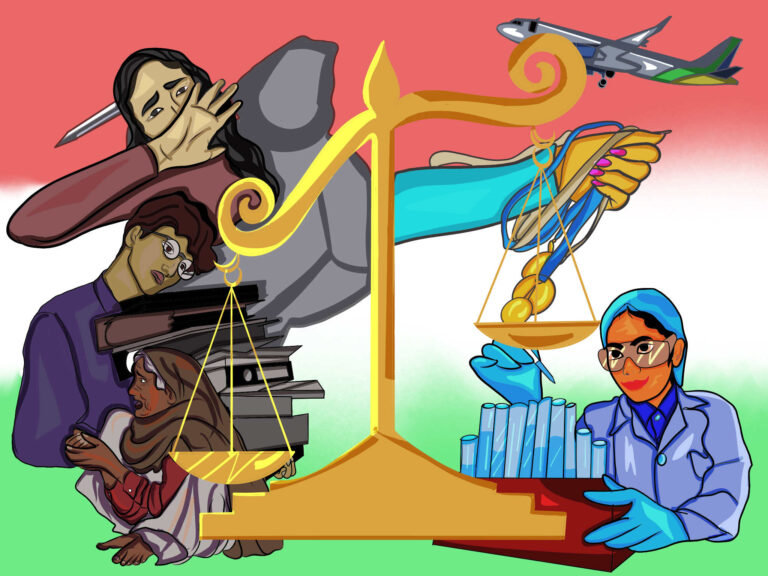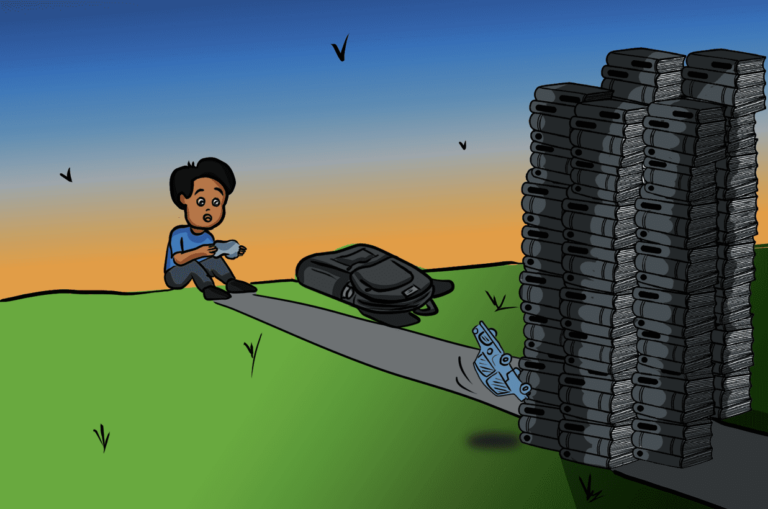A white line and a mosque
Dilip Simeon is a trustee of the AMAN Public Charitable Trust. He formerly taught history at Ramjas College, University of Delhi, and has been active in democratic and anti-communal mobilization for many years.
(Published in Hindustan Times, December 6, 2000)
In the year of grace 1989, I visited the Wagah border with a friend. It was evening, time for the lowering of flags, for the BSF and Pakistan Rangers to perform their beautifully choreographed ceremony with goose-steps and challenging gestures. I saw coolies, uniformed men, and tourists look at each other with friendly curiosity, children being held up on parental shoulders to catch a better glimpse of the Other country, yards near and years apart. Some were chatting with the men in uniform to get permission for a brief foray across the forbidden line. So much symbolic meaning, such deep historic memories concentrated in such an ordinary space – the good old GT Road, Punjab’s lush green fields, eucalyptus trees, two iron gates. And that thick white line.
Have you ever come across the term `sub-liminal’? It means an image which lies just outside one’s awareness. The dictionary defines `liminal’ as being situated in a position on or on both sides of a boundary or threshold. It also means “pertaining to or constituting a transitional or initial stage of a process”; and, “marginal, insignificant, incidental”. I thought more about the word and I realized there were problems, logical ones, which held back my comprehension. What were the defining limits of “an initial stage”? The space of a “process”? Did words like stage, process, position, imply that liminal existence possesses an entity of its own? No, the word sounded like a bit of jargon, of no use to ordinary people…
But when I saw the coolies treading on a white line twelve inches wide I began to understand the ordinariness of liminality. Whom did the line belong to? Was there another razor-sharp line, or a tiny space between the first six inches and the next six inches? Did not the six inches on either side draw into their respective magnetic fields the space up to each gate? Was that space just a few yards broad or did it extend backward for hundreds of miles, incorporating millions of persons? And what of the little crowd which gazed wistfully across the metal barriers? Why did the frontier-tourists secretly wish to imitate the coolies, walk right up to the twelve-inch white line and put their foot across it? What did it mean to go back home and say they had crossed over? How would it be to stand with one foot on either side of the white line? Better still, with both feet squarely on the line’s twelve inches?
Liminality. That was the word for the ambiance surrounding the painted line across the Grand Trunk Road. The footfalls of the coolies, the colors of their shirts, the synchronized steps, the gestures of the soldiers were all markers of their liminal status. The intense desire in many assembled hearts to step across the line, if only for an instant, brought them too, within the sphere of liminality. I began to glimpse the meaning of the term “moment of truth”.
Years later, in the summer of 2000, I visited Northern Ireland. The gently rolling countryside, the blue-green tint in the vegetation, the laughter in the faces of ordinary people. What a beautiful country. I forgot to visit the border to see another artificial line, also drawn by Englishmen. But suddenly, in Belfast, I did not need to. For there, in the middle of neighborhoods, separating one street from another, or the same street from itself was tall sheets of steel, through which not even a ray of light could pass. There were gates blocking roads, kerbs painted with the conflicting colors of Nationalism and Loyalism. There were huge wall murals reminding the Irish of their bloody past, asking them to continue their struggle to unite the Republic despite the objections of the Loyalists or to keep it divided despite the aspirations of the Nationalists. I saw a loyalist mural in which a black-hooded warrior pointed a rifle straight in the face of its viewers. The border was in the street, everywhere. Unity in Separation. “Decommissioning weapons?” said my guide, an Englishman living in Belfast who has devoted himself to communal harmony, like some mad people in my country. “The IRA can easily get fresh weapons. “We have got to decommission the mind”, he said, tapping his forehead.
Weeks later, I found myself outside the stone huts of Bhil rural laborers on the outskirts of Jodhpur. They had taken refuge from religious persecution in Pakistan. Here, officially designated as Pak-Oustees, they live on an allotted space, under government scrutiny, subject to the rapacity of stone-quarry contractors and the lesser constabulary. “What shall we do babu?” one of them asked me. “Over there we were called Hindustanis.. here we are known as Pakistanis. But we are just workers. May we not live in peace?”. I thought sadly to myself, “no, you have to have to carry a border around with yourselves – it’s a part of our glorious historical heritage.”
I approach another threshold, the threshold of comprehension. I think about how nations may suspend themselves in liminality, in frozen contemplation of a painted line bequeathed to them by their forefathers. How communities like to see themselves as mirror images of each other. How ordinary people often avoid self-definition while the commanders of identity insist on clear demarcation. How a sixteenth-century mosque became a twentieth-century disputed structure for a few years, returned to the status of a mosque for a few hours while it was in transition to a heap of rubble, and then, as rubble, was transformed yet again into an imaginary mosque where alone an as-yet imaginary temple might be forthcoming. How such a temple would only have value if it occupied the precise space where stood the ghost of the mosque… Why a spectacle celebrating the sacred weaponry of the Gurus may be fully enjoyed only when the all-too-real weapons of terror have been silenced. Why do those who defy the law get to the position where they lay down the law? Why what is known is often unspoken, and what is spoken is often unknown. Why half-truths are lies on the verge of becoming truths.
I begin to apprehend a liminal space whose boundary is shared by wisdom and ignorance, love and hate, violence and non-violence, means and ends. Liminal because each conjures up the other. Because ignorant people can have flashes of wisdom because hatred is a fixation. Because ahimsa is not the name of passivity and surrender, but of resilience. As long as the circumstances which incubate division persist, non-violence will linger on a sub-liminal threshold. The time spent on that invisible line will be fraught. But tension will be our fate until we cross the barrier, and it vanishes behind us so that we never again want to go back.
My mind transports me back to Northern Ireland, the city of Derry. Not Londonderry anymore. My brief sojourn was marked by an experience of great friendship and warmth from the Irish. I said so to my gracious hostess Mari Fitzduff, a woman who has worked indefatigably for peace over the decades. You are such wonderful, generous, and musical people…my appreciation was loaded with an unspoken question. Her intuitive response told me much about India. “We love strangers, Dilip”, she said, “except our own”. Our strangers. Our mound of rubble. Weep a tear for our disputed structure. That’s liminality for you. For us all.








